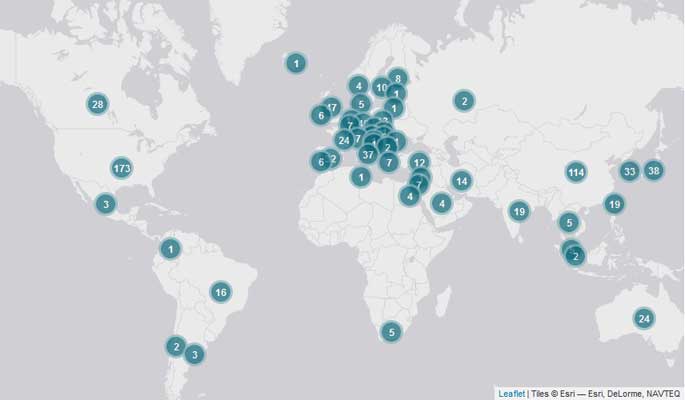- UNIVERSITY
- MEMBERS
- Faculties
- Faculty of Philosophy
- Faculty of Agriculture
- Faculty of Law
- Faculty of Technology
- Faculty of Economics
- Faculty of Technical Sciences
- Faculty of Medicine
- Faculty of Sciences
- Academy of Arts
- Faculty of Civil Engineering
- “Mihajlo Pupin” Technical Faculty
- Faculty of Sport and Physical Education
- Faculty of Education
- Teacher Training Faculty in the Hungarian Language
- Institutes
- University centres
- Foundations, funds, associations
- Faculties
- STUDIES
- SCIENCE
- INTERNATIONAL COOPERATION
- CONTACT
UNIVERSITY OF NOVI SAD ON THE LEIDEN RANKING LIST OF THE BEST UNIVERSITIES IN THE WORLD

Source: http://www.leidenranking.com/ranking/2016/map
University rankings have occupied a prominent place in the assessment of scientific and educational work over the past decades. The most significant world (global) university rankings include the Shanghai Ranking, Leiden Ranking, Webometrics, U-Multirank, and others. A set of indicators is developed for each ranking, estimating contribution to science and education, as well as the impact that scientific publications of a certain university’s researcher have on the development of science in the contemporary society. According to the available data, over 26,000 universities worldwide are covered by rankings, whereas it is estimated that their total number exceeds 40,000.
Leiden University (the Netherlands) has recently published university ranking results for 2016. Only 842 universities are listed. The University of Novi Sad appears on the Leiden Ranking for the first time, occupying the 756th place. This progress is significant both for the academic community of the University of Novi Sad and for the whole country. Last year Serbia only had the University of Belgrade placed on the Leiden Ranking. Starting this year, Serbia has two universities on this list, which ranks it among the most successful countries in the region.
The main criterion applied by the Leiden Ranking is the number of publications indexed in the Web of Science. In order for a university to even be given an opportunity to compete against the universities which will be ranked, it requires at least 1,100 scientific publications. Taking this into account, the evaluation is based on the following indicators: 1. the number of scientific publications that belong to the top 1% of most frequently cited ones in a specific field; 2. the number of scientific publications that belong to the top 10% of most frequently cited ones in a specific field; 3. the number of scientific publications that belong to the top 50% of most frequently cited ones in a specific field; 4. the total and the average number of citations per publication of a university and 5. the total and the average number of citations per publication of a university referring to a specific scientific field. Self-citations are excluded.
The second important criterion refers to a university’s involvement in scientific collaboration, the crucial indicators being the number of publications that have been co-authored with authors from other universities and authors from other countries. Moreover, the geographical distance between countries involved in scientific collaboration is calculated, which can be less than 100 km (countries in the same region) or more than 5,000 km.
The third criterion is a university’s scientific impact.
Placing a university among the best in the world in the Leiden Ranking is a matter of prestige, given that ranking is performed on the basis of strict, accurate, and complex criteria, testifying to an institution’s quality.
The University of Novi Sad was also ranked among the top 1,000 universities in the Webometrics Ranking (886th place) for the first time in 2016.
Site map | Copyright © 1998-2022 University of Novi Sad. All rights reserved. | webmaster: [email protected]


